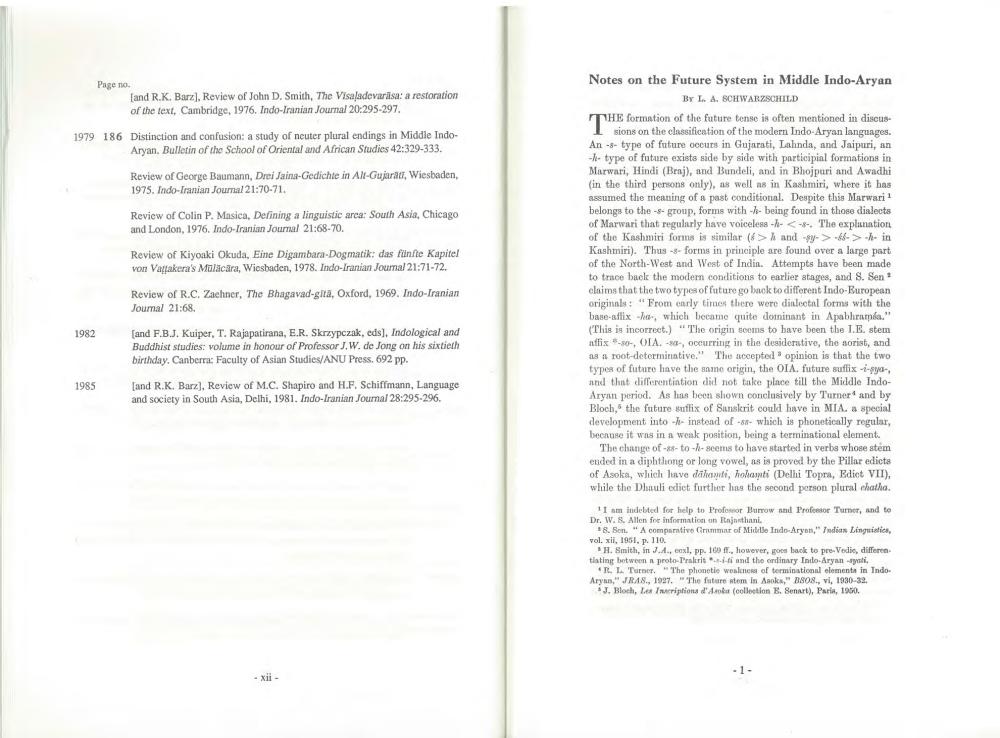________________
1982
Page no.
1979 186 Distinction and confusion: a study of neuter plural endings in Middle IndoAryan, Bulletin of the School of Oriental and African Studies 42:329-333.
1985
[and R.K. Barz], Review of John D. Smith, The Visaladevarasa: a restoration of the text, Cambridge, 1976. Indo-Iranian Journal 20:295-297.
Review of George Baumann, Drei Jaina-Gedichte in All-Gujarati, Wiesbaden, 1975. Indo-Iranian Journal 21:70-71.
Review of Colin P. Masica, Defining a linguistic area: South Asia, Chicago and London, 1976. Indo-Iranian Journal 21:68-70.
Review of Kiyoaki Okuda, Eine Digambara-Dogmatik: das fünfte Kapitel von Vaakera's Müläcara, Wiesbaden, 1978. Indo-Iranian Journal 21:71-72.
Review of R.C. Zachner, The Bhagavad-gitä, Oxford, 1969. Indo-Iranian
Journal 21:68.
[and F.B.J. Kuiper, T. Rajapatirana, E.R. Skrzypczak, eds), Indological and Buddhist studies: volume in honour of Professor J.W. de Jong on his sixtieth birthday. Canberra: Faculty of Asian Studies/ANU Press. 692 pp.
[and R.K. Barz], Review of M.C. Shapiro and H.F. Schiffmann, Language and society in South Asia, Delhi, 1981. Indo-Iranian Journal 28:295-296.
- xii -
Notes on the Future System in Middle Indo-Aryan
By L. A. SCHWARZSCHILD
formation of the future tense is often mentioned in discussions on the classification of the modern Indo-Aryan languages. An -8- type of future occurs in Gujarati, Lahnda, and Jaipuri, an -- type of future exists side by side with participial formations in Marwari, Hindi (Braj), and Bundeli, and in Bhojpuri and Awadhi (in the third persons only), as well as in Kashmiri, where it has assumed the meaning of a past conditional. Despite this Marwari 1 belongs to the -s- group, forms with -- being found in those dialects of Marwari that regularly have voiceless --<--. The explanation of the Kashmiri forms is similar (6> and -sy->-->-h- in Kashmiri). Thus -s-forms in principle are found over a large part of the North-West and West of India. Attempts have been made to trace back the modern conditions to earlier stages, and S. Sen claims that the two types of future go back to different Indo-European originals: "From early times there were dialectal forms with the base-afflix -ha, which became quite dominant in Apabhrama." (This is incorrect.) "The origin seems to have been the I.E. stem affix -so-, OIA. -sa-, occurring in the desiderative, the aorist, and as a root-determinative." The accepted opinion is that the two types of future have the same origin, the OIA. future suffix -i-gya-, and that differentiation did not take place till the Middle IndoAryan period. As has been shown conclusively by Turner and by Bloch, the future suffix of Sanskrit could have in MIA. a special development into h- instead of -sa- which is phonetically regular, because it was in a weak position, being a terminational element.
The change of -as-to-h-seems to have started in verbs whose stem ended in a diphthong or long vowel, as is proved by the Pillar edicts of Asoka, which have dahanti, hohanti (Delhi Topra, Edict VII), while the Dhauli edict further has the second person plural chatha.
11 am indebted for help to Professor Burrow and Professor Turner, and to Dr. W. S. Allen for information on Rajasthani
8. Ben. "A comparative Grammar of Middle Indo-Aryan," Indian Linguistics, vol. xii, 1951, p. 110.
H. Smith, in J.A., eaxl, pp. 160 ff., however, goes back to pre-Vedie, differen tiating between a proto-Prakrit --i-fi and the ordinary Indo-Aryan -synti,
R. L. Turner. "The phonetic weakness of terminational elements in IndoAryan," JRAS., 1927. "The future stem in Aaoks," B808., vi, 1930-32. J. Bloch, Les Inscriptions d'Asoka (collection E. Senart), Paris, 1950.
-1




